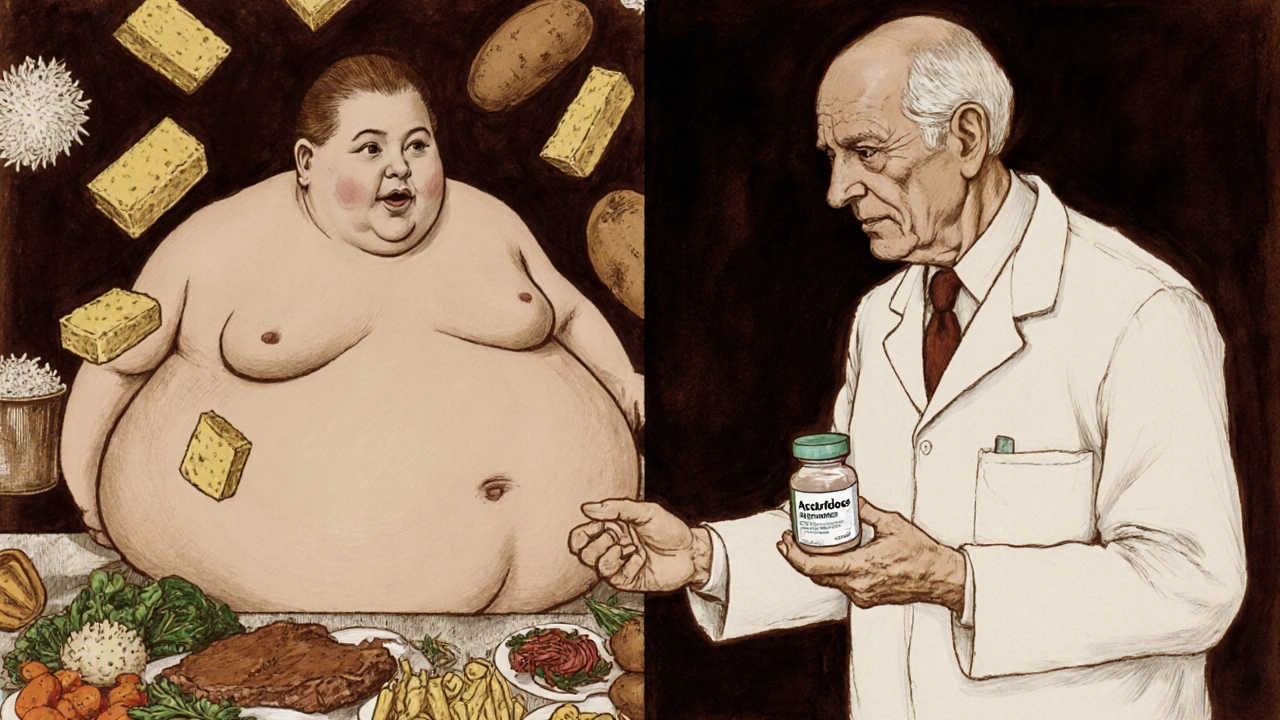Carb Intake Management Tool
How This Tool Helps You
This tool helps you track your carbohydrate intake to minimize side effects from alpha-glucosidase inhibitors while maintaining effective blood sugar control. Research shows that limiting carbs to 30-45g per meal can reduce gas and bloating by up to 50%.
Your Carb Target
Daily carb limit: 120-180g
Per meal target: 30-45g
This range is based on clinical studies showing reduced side effects while maintaining blood sugar control.
Input Your Meals
Current Intake
Total Carbs Today: 0g
0% of daily limit used
Your Guide
Add meals to see personalized guidance based on your carb intake.
When you’re managing Type 2 diabetes, the goal isn’t just to lower your blood sugar-it’s to do it without making your daily life unbearable. That’s where alpha-glucosidase inhibitors come in. These drugs, like acarbose and miglitol, help control the spike in blood sugar after meals by slowing down how fast your body breaks down carbs. Sounds great, right? But for many people, the trade-off is a constant battle with gas, bloating, and diarrhea. If you’ve been prescribed one of these medications and are wondering why you feel like a pressure cooker after every meal, you’re not alone.
How Alpha-Glucosidase Inhibitors Actually Work
Alpha-glucosidase inhibitors don’t make your body produce more insulin or burn more glucose. Instead, they block enzymes in your small intestine-specifically alpha-glucosidase-that normally break down complex carbs like bread, pasta, and potatoes into simple sugars. Without these enzymes doing their job, the carbs pass through undigested into your colon. There, gut bacteria feast on them, producing gas as a byproduct. That’s the root of the problem: your body isn’t digesting the food the way it should, so your gut bacteria are left to clean up the mess.
This mechanism is why these drugs are uniquely effective at reducing post-meal blood sugar spikes-by as much as 40-50 mg/dL-without causing low blood sugar or weight gain. That’s a big deal for people who are overweight or older and can’t risk hypoglycemia from other diabetes drugs like sulfonylureas. But the same science that makes them useful also makes them hard to tolerate.
Why Gas, Bloating, and Diarrhea Happen
Here’s the reality: up to 73% of people starting acarbose or miglitol experience excessive gas in the first month. About 30% report bloating, and 1 in 5 develop diarrhea. These aren’t rare side effects-they’re the norm. The reason? Undigested carbs reach your colon, where bacteria ferment them. That fermentation produces hydrogen, methane, and carbon dioxide-the gases that cause discomfort. The osmotic effect of those undigested carbs also pulls water into the colon, leading to loose stools.
Unlike metformin, which often causes nausea or upper GI upset, alpha-glucosidase inhibitors hit the lower gut hard. You won’t feel sick to your stomach-you’ll feel like you’re trapped in a balloon after eating rice or pasta. And because these drugs stay mostly in your gut (only 1-2% enters your bloodstream), their side effects are local, not systemic. That’s why you don’t get dizziness or liver issues-you just get a very unhappy colon.
Who Still Uses These Drugs Today?
In the U.S., alpha-glucosidase inhibitors make up less than 3.5% of all diabetes prescriptions. That’s down from over 5% just five years ago. Why? Because newer drugs like GLP-1 agonists and SGLT2 inhibitors offer better results with fewer gastrointestinal headaches. But they’re not gone. They’re still used in specific cases:
- People who can’t afford newer medications-generic acarbose costs $15-$25 a month.
- Elderly patients who need to avoid hypoglycemia.
- Those with kidney problems who can’t take metformin or SGLT2 inhibitors.
- Patients in Asia, where high-carb diets make these drugs more effective and more commonly used.
Doctors don’t prescribe them first anymore. But when other options are off the table, they’re still a viable tool. Especially if you’re okay with managing the side effects.

Real People, Real Experiences
On patient forums, the stories are split. One Reddit user wrote: “I started acarbose at 50 mg three times a day. The gas was so bad I couldn’t leave the house. My doctor said it would get better. It didn’t. I quit after two weeks.” Another person on HealthUnlocked said: “After six months, I was having diarrhea every day. My clothes didn’t fit anymore.”
But not everyone gives up. A Drugs.com review from September 2023 said: “The first month was awful. But by month three, the gas cut in half. My after-meal sugars dropped from 220 to 160. It’s worth it.” The difference? They adjusted their diet and took the drug slowly.
Studies show that people who get proper education and dietary guidance are nearly twice as likely to stick with the medication. It’s not about willpower-it’s about strategy.
How to Reduce the Side Effects (Without Quitting)
If you’re on acarbose or miglitol and want to keep using it, here’s what actually works:
- Start low, go slow. Don’t jump to 100 mg three times a day. Begin with 25 mg once a day with your biggest meal. Wait a week, then add a second dose. After another week, add the third. This gives your gut time to adapt.
- Watch your carbs. Cut back on white bread, white rice, potatoes, and sugary snacks. These are the worst offenders. Replace them with whole grains, legumes, and vegetables. Aim for 30-45 grams of carbs per meal-not more.
- Avoid Beano. It sounds like a fix, but it contains alpha-galactosidase, which breaks down carbs before they reach your colon. That defeats the whole purpose of the drug. You’ll lose the blood sugar control.
- Try simethicone. Over-the-counter gas relief like Gas-X or Mylanta Gas can help with bloating. Take 125 mg before meals.
- Use loperamide if needed. For diarrhea, Imodium A-D (2 mg as needed) is safe and effective. Don’t use it daily unless your doctor says so.
- Stay away from high-fat meals. Fat slows digestion and makes diarrhea worse. Stick to lean proteins and healthy fats in moderation.
One study from the London Diabetes Centre found that patients who got 30-minute coaching on diet and dosing were 45% less likely to quit the drug within 12 weeks. That’s not magic-it’s education.
When It’s Time to Stop
Some people just can’t tolerate it. If you’ve tried the slow titration, adjusted your diet, and still can’t leave the house without planning a bathroom route, it’s okay to stop. About 15-20% of people discontinue these drugs within three months. That’s not failure-it’s data.
There’s no shame in switching to another medication. Metformin, SGLT2 inhibitors, or even GLP-1 agonists (if cost allows) might be better fits. Your doctor can help you transition safely. Don’t feel guilty for giving up on a drug that’s making you miserable.
What’s Next for These Drugs?
There’s no new alpha-glucosidase inhibitor coming to market. But research is exploring ways to make them easier to take. A 2023 trial combined acarbose with specific probiotics-Lactobacillus acidophilus and Bifidobacterium lactis-and saw a 35% drop in gas severity. That’s promising. If a probiotic combo gets approved, it could revive interest in these drugs.
For now, they’re a niche tool. Useful for specific people. Hard to live with for many. The key isn’t to avoid them entirely-it’s to understand them, manage them, and know when they’re not worth the cost.
Do alpha-glucosidase inhibitors cause weight gain?
No. Unlike some other diabetes medications, alpha-glucosidase inhibitors don’t cause weight gain. In fact, because they reduce calorie absorption from carbs, some people lose a small amount of weight-usually 1-3 pounds over several months. This makes them a good option for people with obesity and Type 2 diabetes.
Can I take these drugs with other diabetes medications?
Yes. Alpha-glucosidase inhibitors are often used as add-on therapy with metformin, DPP-4 inhibitors, or even insulin. They work differently than most other drugs, so they can complement them well. But always check with your doctor-combining them with sulfonylureas can increase the risk of hypoglycemia, and you’ll need to treat low blood sugar with glucose tablets or juice, not regular food, because the drug will slow down digestion.
How long does it take for the side effects to get better?
Most people notice improvement after 6-12 weeks. Your gut bacteria gradually adapt to the undigested carbs, producing less gas over time. By six months, flatulence rates drop from around 70% to about 25%. But this only happens if you stick with the medication and follow dietary advice. Quitting early means you never give your body a chance to adjust.
Are there any foods I should avoid completely?
Avoid highly processed carbs: white bread, pastries, sugary cereals, potatoes, and fruit juices. These are broken down quickly and cause the worst reactions. Also avoid beans, cabbage, and broccoli in large amounts-they’re high in fiber and can worsen gas. You don’t need to eliminate them entirely, but eat them in smaller portions and pair them with protein to slow digestion.
Is there a difference between acarbose and miglitol?
They work the same way, but miglitol is slightly more absorbed into the bloodstream (about 3% vs. 1-2% for acarbose). This means miglitol might cause slightly more systemic side effects, like mild dizziness, though both cause similar GI symptoms. Acarbose is far more commonly prescribed-about 90% of cases-because it’s cheaper and has more long-term data.
Final Thoughts
Alpha-glucosidase inhibitors aren’t the flashy new diabetes drugs you hear about in ads. They don’t help you lose weight or protect your heart. But they do one thing well: blunt post-meal sugar spikes without causing low blood sugar. And for some people-especially those on a budget, with kidney issues, or who can’t tolerate other meds-they’re still worth trying.
The catch? You have to be prepared for the side effects. It’s not about being tough-it’s about being smart. Start slow. Eat smart. Talk to your doctor. And if it’s too much after a few months, switch. There’s no prize for suffering through a drug that doesn’t fit your life. Your health isn’t just about numbers on a glucose meter. It’s about feeling okay in your own skin, every day.






Written by Martha Elena
I'm a pharmaceutical research writer focused on drug safety and pharmacology. I support formulary and pharmacovigilance teams with literature reviews and real‑world evidence analyses. In my off-hours, I write evidence-based articles on medication use, disease management, and dietary supplements. My goal is to turn complex research into clear, practical insights for everyday readers.
All posts: Martha Elena